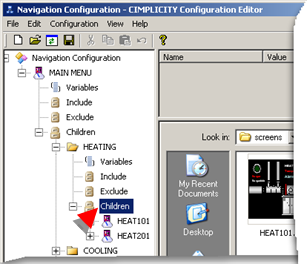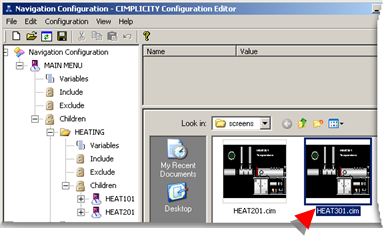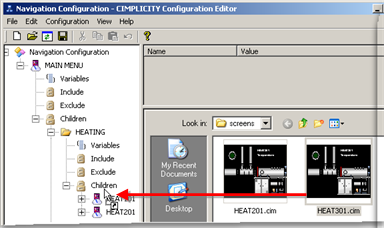Any extended menu node that uses an overlay action or no action can have as many children as required; the levels can go as deep as required.
Expand the node that will have the child added.
Select Children.
Note: There are no configuration options in the right pane when Children is selected.

Methods to add a child node are as follows.
|
Drag a screen to the Children icon. |
|
|
Use the Navigation Configuration Editor's menu items. |
Drag a screen to the Children icon
![]() Note: Dragging and dropping a screen speeds up
configuration when the node will use an Overlay action type, which
is one of three action types available for node configuration.
Note: Dragging and dropping a screen speeds up
configuration when the node will use an Overlay action type, which
is one of three action types available for node configuration.
Select a screen in the Navigation Configuration window lower right pane.

Drag the screen to appropriate Children folder in the left pane.

The screen file name displays as the node name.
(Optional) Rename the node name.
Select the child node.
Do one of the following.
![]() Right-click the name; select
Rename on the Popup menu.
Right-click the name; select
Rename on the Popup menu.
![]() Select Edit>Rename on the
Configuration Editor menu bar.
Select Edit>Rename on the
Configuration Editor menu bar.
![]() Press F2
on the keyboard.
Press F2
on the keyboard.
The name can now be edited.
Type in the name that should display on the menu bar.
(Optional) Change the icon.
When the screen is dragged to create the node, the default icon will display in the tree. The icon can be changed.
Select the child node.
Do one of the following.
![]() Click Edit>Change Icon on the
Navigation Configuration Editor menu bar.
Click Edit>Change Icon on the
Navigation Configuration Editor menu bar.
![]() Right-click the child node; select
Change Icon on the Popup menu.
Right-click the child node; select
Change Icon on the Popup menu.
Select the icon you want to use for the node.
Default:
![]()
![]()
Result: The child node will now display on the menu bar; the screen that will display is automatically entered in the Overlay parameters Screen name field.
Use the Navigation Configuration Editor's Menu Items
Select the appropriate Children object in the Navigation Configuration Editor left pane.
Do one of the following.
![]() Right-click Children; select Add Configuration Object on the
Popup menu.
Right-click Children; select Add Configuration Object on the
Popup menu.
![]() Click Edit>Add Configuration
object on the Navigation Configuration Editor menu bar.
Click Edit>Add Configuration
object on the Navigation Configuration Editor menu bar.
An Add Configuration Object dialog box opens.
Enter the following.

|
Field |
Description |
|
|
Name |
Name that will display on the Menu bar. |
|
|
Type |
The Navigation Node is the button that a user will click in CimView to perform a navigation action, e.g. navigate to another screen. |
|
|
Icon |
Another icon can be selected from the icon drop down list to represent the node. |
|
|
|
Default |
|
Click .
Result: The Add Configuration Object dialog box closes; The name that was entered displays as the root node name in the Navigation Configuration window left pane.
![]() Important: When the child is added using the Add
Configuration Object dialog box, an action type and specifications
required for that action type will have to be entered before the
navigation configuration can be saved with no errors.
Important: When the child is added using the Add
Configuration Object dialog box, an action type and specifications
required for that action type will have to be entered before the
navigation configuration can be saved with no errors.
|
Step 2.1. Add nodes for the extended menu. |